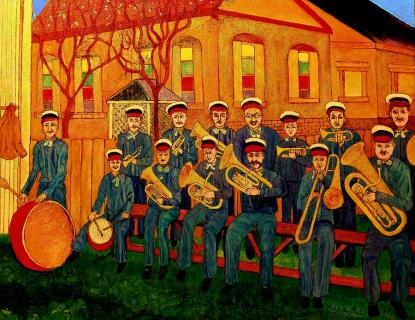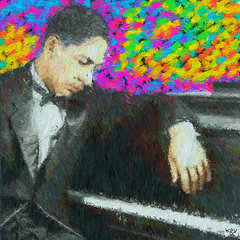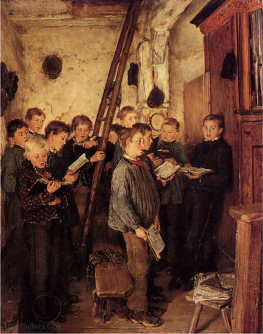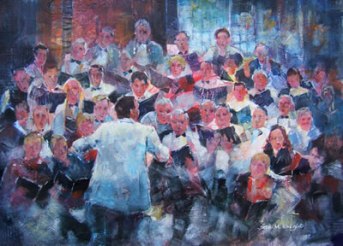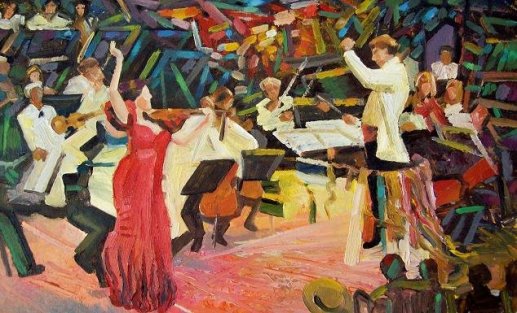Musical ensemble. International theoretical usage includes under this term most Indonesian or Malay ensembles that have gongs, gong-chimes, metallophones, and drums. These are found in Indonesia, Malaysia, Surinam, and scattered places around the Western world. This usage is seldom extended to include ensembles with similar components that are found on mainland Southeast Asia (excluding the Malay peninsula) and in the Philippines. The usage closest to that found most often in Java encompasses ensembles that play Javanese music in the slendro and pelog tunings. These include ensembles with few or no metallophones, gong-chimes, or gongs; for example, zitran, angklungan, and reyog ensembles, which feature plucked chordophones, shaken bamboo rattles, and quadruple-reed aerophones, respectively. In gamelan that have fixed-pitch instruments with a range greater than two octaves, the pitch and interval structures of the slender and pelog tunings usually differ from octave to octave, and the pitch and interval structures of these tunings usually differ from one gamelan to another.
Monthly Archives: July 2014
fanfare
(1) Music played by trumpets or other brass instruments, sometimes accompanied by percussion, for ceremonial purposes, especially to call attention to the arrival of a dignitary or to the beginning of a public ceremony; also termed a flourish, as in the “Ruffles and Flourishes” played by military bands in the U.S. to announce the arrival of the President. The term is sometimes extended to include military and hunting signals of similar character. Since such music was historically performed on *natural instruments, it is often characterized by the use of pitches from a single harmonic series (e.g., c, c’, g’, c”, e”, g”). It has often been imitated in art music (as early as the 14th-century Italian *caccia), and examples in opera include that for the arrival of the governor in the second act of Beethoven’s Fidelio. Examples by 20th-century composers include Copland’s Fanfare for the Common Man for brass and percussion (1942) and Stravinsky’s Fanfare for a New Theatre for two trumpets (1964). (2) A brass band.
progression
A succession of two or more chords; also chord progression, harmonic progression; in jazz and popular music also termed changes.
pedal point
[Fr. pédale; Ger. Orgelpunkt; It. pedale; Sp. bajo de órgano, nota pedal]. A sustained tone in the lowest register, occurring under changing harmonies in the upper parts; also pedal, organ point. In tonal music, pedal points may occur on any scale degree (and are often identified by the name of the scale degree), but the most common are those on the dominant, preparing a climactic return to the tonic, and on the tonic, as the final, summarizing statement of the tonic at the conclusion of the work [Ex.]. In organ music, where some of the most characteristic examples occur, such tones are typically played on the pedalboard. A similarly sustained tone in an upper register is sometimes termed an inverted or internal pedal. Sustained tones in the lowest voice are a salient feature of certain types of organum, and in the form of the drone, sustained tones used in conjunction with moving parts are widely distributed geographically and historically.
interlude
Music played between sections of a composition or of a dramatic work [see also Act tune, Entr’acte, Intermède, Intermedio, Intermezzo, Zwischenspiel]. In a dramatic work, it may be purely instrumental music or may include action or narration related to the principal work. In purely instrumental music, it may serve to connect larger movements or sections. In church music, the term is applied to music (often improvised) played between verses (sometimes between lines) of a hymn or Psalm. Pieces of this type were published in 18th-century England by Daniel Purcell, Samuel Wesley, and others. The German Protestant tradition of inserting music between the lines of chorales is reflected in some *organ chorales of Bach (e.g., In dulci jubilo BWV 729).
ragtime
A composed instrumental genre, primarily for piano and principally created by black Americans, that combines syncopated melodies with the forms of the march; the syncopated style of this genre. Piano rolls played an important part in the dissemination and popularization of ragtime. Existing also in various ensemble arrangements, classic rags of Scott Joplin (1868-1917), James Scott (1886-1936), and Joseph Lamb (1887-1960) present three or four distinct 16-bar themes (strains) in duple meter. Tempos are the most often moderate, suitable for dances such as the cake-walk, two-step, one-step (in a fast tempo), or polka.
melisma [Gr., melody]
A group of more than a few notes sung to a single syllable, especially in liturgical chant. In Gregorian chant, melismas are articulately characteristic of the alleluia, the gradual, the tract, and the great responsory. They may consist of as many as several dozen notes. During the Middle Ages, melismas of even greater length were adde to some responsories, sometimes having been borrowed from other types of chancy such as the offertory.
A piece with good examples of melisma: http://www.youtube.com/watch?v=vINtvVjcCm4
motet
A major musical genre from the 13th through the 18th century, of minor importance thereafter. Because no single definition can encompass the characteristics of the motet during the entire course of its development, it is helpful to distinguish three major phases. In the first (ca. 1200-1450), the term motet denoted a particular structure: a tenor derived from chant that serves as the foundation for newly composed upper voices; the resulting composition is heterogeneous both in the musical style of the individual voices and in their texts. In the second phase (ca. 1450-1600), motet denoted a genre: a polyphonic setting of a sacred Latin text. In the third phase (after 1600), the term, while retaining its basic meaning as a type of sacred music, became associated with a particular style (stilus motecticus): the serious, imitative style of church polyphony derived from Palestrina.
cadenza [It., cadence]
In music for soloist, especially a concerto or other work with accompanying ensemble, an improvised or written-out ornamental passage performed by the soloist, usually over the penultimate or antepenultimate note or harmony of a prominent cadence. During a cadenza the accompaniment either pauses or sustains a pitch or a chord.
Although a cadenza may occur elsewhere, it most typically ornaments a prominent tonic cadence, such as one before a final ritornello or coda.
